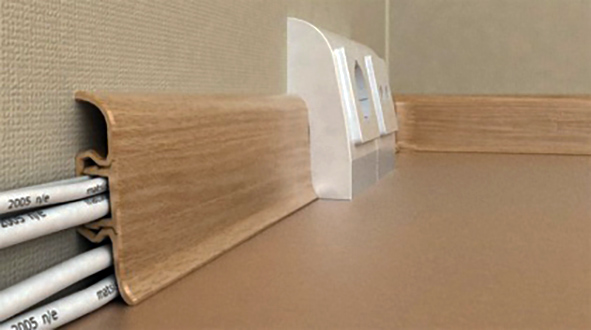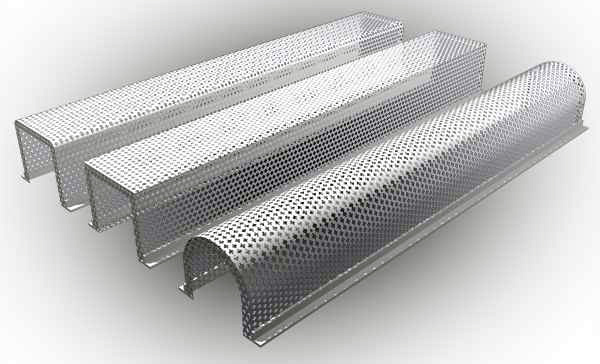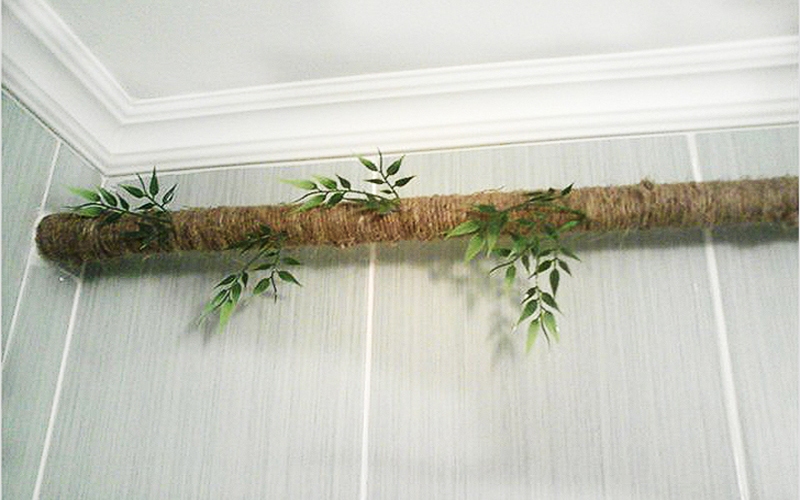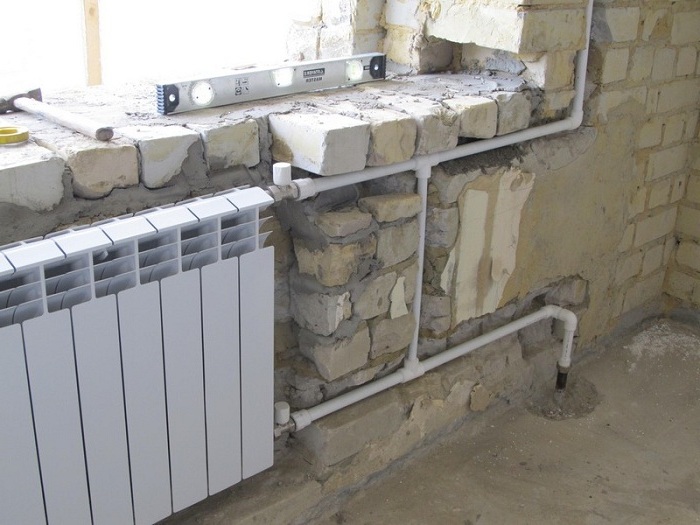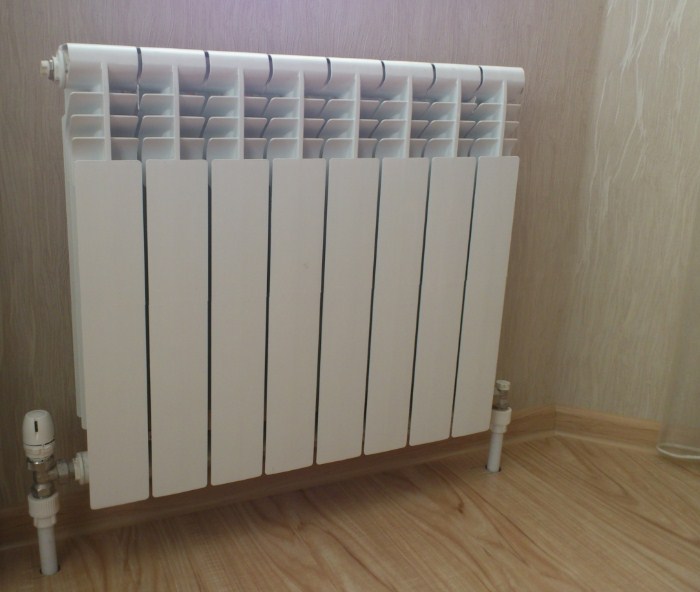Options for closing heating pipes
You can use decorative overlays for pipes. This will help reduce the cost of equipment for the heating system. Sometimes this is a fairly economical option.
Functions of decorative overlays:
- Hiding batteries and pipes in whole or in part;
- Protective function from hot radiators;
- Inscribing the box in the design of the room;
- Simplifies care, as dust does not settle on the battery;
- Some overlay options help distribute heat evenly.

But when choosing a decoration, it is important to consider not only beauty, but also practicality. It is necessary that the material does not reduce heat transfer and does not emit toxic substances during heating.
Plastic, for example, must withstand high temperatures for a long time. It is also important that the material does not change color or shape during operation.
Decoration should not stand in the way of the heat transfer of the radiator.
A decorative box must comply with a number of parameters when used. The overlay should not take up much space, you should choose the most compact options. The fastening of the structure must be strong enough, but at the same time it is necessary to provide for the possibility of access to the batteries
It is also important that the box is not too heavy.
How to hide heating pipes in a private house methods and materials
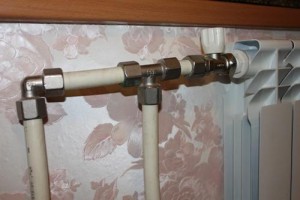
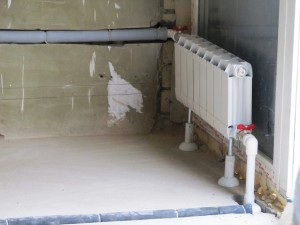
Battery decoupage
To decorate a battery using decoupage technique, materials such as:
- drawing for battery decor using decoupage technique;
- acrylic paints;
- PVA glue;
- white enamel;
- brushes;
- sandpaper;
- heat resistant varnish.
In order to decoupage the battery, you need to prepare it. To prepare, you need to clean the battery, go over the sandpaper and remove excess old paint and create a smooth, even surface.
After sanding, wash the heating radiator and wait until it dries completely. Only then can you start painting.
To paint the battery, it is better to use white enamel, but not nitro.
Through knocks, when the battery is dry, take a drawing or a napkin for the battery decoupage technique and measure the width of the outer surface.
It all depends on the pattern you choose. We glue our drawing in the center of the battery rib.
To glue the picture, take PVA glue and dilute it with water in proportions of 1: 1, in this state it will better lie down on paper.
Having thus glued the entire drawing, you need to paint over the part of the battery remaining without a napkin with acrylic paints. If you draw well, then you can supplement the decoupage of the battery with brushes.
When the decoupage on the battery dries, cover it with heat-resistant varnish.
You can also make a battery decor with other patterns. Usually use different colors and patterns.
Pipe decor
Pipes, like batteries, can be decorated in an original way.There are several options for decorating pipes with your own hands:
- wrap pipes with thick threads or ropes;
- tie a cover for pipes, which will be applied to the pipe;
- paint the pipe in original colors, for example, in multi-colored stripes.
The last option, which involves painting, may require different colors of paint, but it is ideal for a child's room.
How to make a pipe decor with a hook and thread
It is enough just to tie a certain long knitted strip, the width of which will correspond to the size of the pipe girth. The strip may not be annular, and it is not at all necessary to make a cover out of it.
To decorate the pipe, you only need loops placed in a certain sequence, but you can make them in the knitting process in accordance with the selected pattern.
A rope similar to a lace will be threaded into these loops, which will either be tied at the bottom or at the top, or in several places will be tied into a beautiful bow.
Rope pipe decor
Another option for decorating unsympathetic pipes is the use of a beautiful structural rope.
She simply needs to tightly wrap pipes with a vertical arrangement of strips. To secure the rope in the process of refueling its ends, you must use glue.
Decoupage pipes
You can decorate pipes using decoupage technique. To do this, you will need either a special decoupage film, which is sold in a needlework store, or ordinary napkins with a suitable pattern.
As a rule, shabby chic decoupage involves the use of light, warm and delicate colors. To decorate the pipe, you need to perform the following sequence of actions:
- pre-clean the surface for decorating the pipe;
- apply glue to the pipe;
- cover the surface with a napkin;
- smear with glue again so that the entire napkin is soaked through for better adhesion;
- varnish.
The pattern on the napkin can be cut out if the pattern that suits you is shown there. As a background, you can use another napkin with soft colors, which in no case should be cut.
The ideal solution for decorating pipes using decoupage technique is to tear, so the background borders will be smooth.
Pipe decor can be very different. For example, you can paint a pipe in the form of a birch tree trunk, and attach sheets cut out of paper to the walls, which will create an original image of a tree or replace the sheets with artificial ones.
Decorative grille on the radiator
The grille for the radiator is a great decoration and a way to disguise. The simplest option for creating such a lattice is a construction of bamboo rods. The rods should be thick, while they will be easy to cut, adjusting the size of the grille to the size of the radiator.
The rods can be fixed with wire or glue, but the glue will of course be less visible.
The radiator can be disguised as a fireplace by making a wooden mesh for it, decorated with different patterns. Such a fireplace fits perfectly into almost any type of interior, if it is attached to the wall.
Like door decor, decorating pipes, radiators and radiators can require painstaking work, imagination and a lot of time, but with the help of decor you can hide what spoils the appearance of your home design.
Masking of heating pipes
It doesn’t matter if it’s an apartment or a house, a bedroom or a kitchen, I would like to have a good repair everywhere. Questions immediately arise: how to hide heating pipes beautifully and how can this be done with minimal cost and maximum efficiency? At the same time, the method of disguise should be really invisible and inconspicuous, fitting into the room.
The pipe can be hidden inside the wall, and it can also be closed to the floor. Remember that the old heating system should not be hidden in this way, this option is possible after a complete renovation of all elements.
Box on frame
It is best to make it from wood, plastic or drywall. Do not place the heating pipes close, there must be at least three centimeters between the duct and the pipe.
hide behind decor
Decoration of pipes with various options, for example, wrap with jute rope. But remember that this reduces heat transfer. Many homeowners decorate their chimneys with flowers, this can be done with bamboo leaves. Only fantasy should work here, even an old pipe can look completely different.
Wall color painting
The easiest and most practical method is to paint the radiators or riser in the color of the walls, while the heat generation will not decrease.
In the photo in the interior of the kitchen, the pipes are painted in the color of the blue walls.
Hide under floor skirting
A good invention was the floor plinth, in which you can easily hide batteries located horizontally and low to the floor.
Which decorative screen is better
At the moment, decorative boxes for pipes of heating systems are made from the following materials:
- plastic;
- metal;
- MDF;
- wood.
Plastic is one of the most unfortunate materials for making boxes designed to hide hot pipes. The fact is that in order to reduce the price, manufacturers use inexpensive types of plastic for these products. Such material quickly warps from heating, loses its appearance, and even turns yellow, becomes brittle. Of all the types of screens, a plastic pipe box is the cheapest, but it does not last long, it is well suited as a temporary solution to the issue. Attention deserves a plastic box made under the plinth, but this is a different price category.
Metal is the opposite, the best solution for decorative fencing of heating risers and mains. Products with frequent perforation or in the form of a lattice are especially good. Metal is an excellent conductor of heat and will successfully transfer it to the room, and through the holes the casing will let enough air in for heating. So from a technical point of view, metal has no equal.
In terms of operation, steel products are also on top. They are covered with a durable polyester powder coating that can withstand high temperatures and various mechanical stresses. Again, metal boxes can always be repainted if something happens, so they will last a long time. Well, the last argument in favor of steel screens: they are easy to clean in any way, even wipe with a rag, even remove and wash in the bathroom under running water.
Tube decor in the kitchen and bathroom
If you need to hide and decorate communications in the kitchen, then this is easy to do using a furniture set. So horizontal risers can be easily hidden behind a kitchen cabinet.
The vertical pipe can easily be veiled with a floor stand. With a small budget, you can safely use furniture that imitates the real one. Fake designs will help to easily hide unsightly communications that do not fit into the overall design of the room.
You can disguise a gas pipe using parts of a furniture set. This method is the most optimal. You will not only hide the pipes, but if necessary, you will have free access to the column, fittings and counter.
You can also decorate any heating pipe in the bathroom easily and quickly enough. This can be done using the methods described above or any others. It is recommended that before starting work, clarify information about what material the pipe is made of: stainless metal, plastic, etc. Most modern materials do not need to be stained. If the pipe is made of ferrous metal, then it must be cleaned of old material before painting.
There are many ways to decorate a pipe. After weighing all the pros and cons, you can find the best option for yourself.
When choosing it, it is important that the overall stylistic idea in the room is preserved.
Any unsightly pipe can be made an original decorative element in the room. When decorating, do not forget that a heating or gas pipe must, first of all, fulfill its main functional task. If you are creative, the result will exceed all your expectations.
How to hide wires
Surely, before starting repairs, many people think about how to hide the wires in an apartment or private house so that they do not spoil the interior.
The advantage of repair is that before finishing work, you can plan the required number of sockets and switches, so that you do not install additional ones later when all work is completed. In addition, you can draw up a wiring diagram embedded in the walls, so that later you do not accidentally interrupt one or another wire.
First of all, consider how many sockets you will need and for what appliances. Then you need to punch a wall for wires. All wires are either horizontal or vertical. Diagonal placement is not allowed. The distance from the ceiling and from the floor is maintained at about 15-30 cm. In addition, all wires are removed from corners, windows and doors.
How to hide wires? There are two ways to hide wires - open and closed. So, open involves the use of corrugations, pipes and boxes, installation behind skirting boards and decorative panels. Sometimes it happens that this is the only way to install. For example, in a house made of timber, where chasing logs is simply unrealistic. The open way to hide the wires has its advantages - you can quickly get to the place in case of damage.
A closed way to hide wires is wall chasing and installation under plaster. After completing all the finishing work on the wall, only the end points are visible - sockets. The advantage of this method is obvious - the wires are not visible, they do not interfere and do not spoil the interior. But even in the event of a break, it is difficult to get to such a wire - you will have to ditch the wall again.
Sometimes you have to combine the open method of wiring with a closed one. For example, power cables can be hidden in the wall, and low-voltage cables - telephone, Internet, TV - in boxes. There is an explanation for this method: the electromagnetic field created by the power cable interferes with the operation of low-power wiring.
The most common way to hide communications today is to lay them in the walls, in GVL boxes, in a floor screed or under a stretch ceiling. The downside of this installation is the inaccessibility of wires and pipes in the event of a breakdown or leakage - you will have to completely open the walls, remove the screed and stretch ceilings.
If there is no way to hide communications, then you can go the other way - disguise or decorate them. So, for example, you can use ribbons, lace, even ropes to decorate pipes. Or you can just paste over them with the same wallpaper that the walls are pasted over.
Seal pipes with a special box
This method can be successfully used in the repair of existing communications. The first thing to do is to decide on the material of the box. The box is usually made of the following materials:
- drywall;
- tree;
- special profile;
- plastic;
- metal.
Installation of a drywall box for heating pipes and a wooden box
The cheapest way is to close the heating pipes with drywall. This material is easy to process, and with its help you can make a frame of almost any shape. Having installed such a box, it remains only to finish it. All modern finishing materials for interior decoration are suitable for this - wallpaper, tile, lining, stucco, etc.
Such a box can become an adornment of any room, with its help it is easy to create a unique design.It is suitable not only for hiding pipes, but also for creating niches for batteries (radiators). For servicing pipes and batteries in such a box, special hatches can be provided to allow them to be serviced during repairs.
In the manufacture of a drywall frame, the following operations are carried out:
- mark with a pencil, a ruler, a level and a plumb line the contours of the proposed frame;
- a guide metal profile is installed along the drawn lines; it is fixed with dowels or shock-absorbing tape;
- then insert elements of the racks into the profile; the fastening of the profiles to each other is carried out using metal screws;
- the frame thus obtained is sheathed with drywall; for its fastening to the frame, screws are used, the caps of which are inserted into the drywall body no deeper than 1 mm;
- seal the attachment points and seams with putty;
- external and internal corners are reinforced with an angular metal profile;
- primed the finished structure, if necessary - putty;
- then perform the finishing of the box.

Production of a drywall box for closing heating pipes
The box can also be made of wood. This will help solve the question of how to hide the pipes if drywall is not available at a particular time, but there are decent wooden planks available. Especially the use of wood for arranging the box will be relevant if the room itself is finished with wood. This will help maintain its original appearance.
Other wood-based materials, such as MDF, chipboard, especially with a laminated finish, can also be used to seal pipes.
Installation of a plastic box for heating pipes
Plastic boxes for heating pipes are also very relevant, especially when it comes to how to close up a heating pipe in a bathroom, corridor, kitchen and other utility rooms.
The procedure for manufacturing a plastic box is as follows:
- mark the frame of the future box; use a pencil, level, ruler;
- from metal profiles we mount the frame of the box (similar to the frame for plasterboard sheathing);
- cut out plastic parts with a hacksaw;
- with self-tapping screws, special brackets or ordinary small nails, we fasten the prepared parts to the frame;
- we close the joints of plastic elements and their fit to the walls with special decorative corners, starting and finishing elements, as when installing a plastic lining.
You can also use metal boxes. They are made of stainless or chrome steel. These are very durable boxes.
In addition, the metal gives off heat well, which is not unimportant for space heating. Such metal boxes are most often made when decorating a high-tech room.
Photo in the interior of the rooms
Kitchen
The kitchen is the perfect room in which all the ways to hide the batteries become practical and convenient. If the room is small, then you can hide the battery using a beautiful tabletop or make a folding table, which, if possible, will unfold.
Metal-plastic structures factories offer a large selection of beautiful large-sized window sills that imitate stone, wood and other materials. A modern window sill does not break under weight, is not afraid of external factors, it is easy to care for it, wipe it, it is not afraid of scratches and so on. Any kind of battery can be hidden in this way, including cast iron.
In the photo, wooden boxes are used to mask the radiators.
Living room
If the radiator is in a niche, then a wide window sill will help create a working area.
Souvenirs, vases or flowers in pots can be placed on the designed wooden box. You can also close unsightly batteries in the living room with blackout curtains.
Pictured is a modern living room.In order to hide the radiators, a wooden structure was mounted, which also serves as a place for rest, storage and decoration.
Bedroom and nursery
In the interior of the bedroom and nursery, batteries can be used as another place to relax, a tabletop for decorative elements or a workplace.
Bathroom
You can hide the pipes in the bathroom using a louvered door, plastic gratings or a cabinet with opening doors.
We hide heating batteries with the help of wooden, glass or plastic screens.
In the photo, the radiators in the bathroom are hidden using a wooden box.
Hallway
For radiators in the hallways, glass screens or wooden boxes are suitable. In a small room, you need to close the battery only from the point of view of practicality. It can be a shoe storage cabinet, or the battery will become a small coffee table where keys and other necessary items will be stored.
Option to hide heating pipes in the wall
Pipes located along the wall can spoil not only the appearance of the wall, but also the interior design of the entire room. But first of all, we want to inform you that it is strictly forbidden to close the heating pipes in the apartment by hiding them in the wall or under the floor.
- Firstly, there is a law that prohibits, without the consent of the housing office, to carry out “reconstruction of a residential building, which is the installation, replacement or transfer of engineering networks ...”, and it is not so easy to get permission there.
- Secondly, this case can be risky in multi-apartment residential buildings, since if a capitally immured riser breaks, you can pretty much flood the neighbors, because not all plumbers are experienced, and some may cheat, as a result of which, all the trouble will eventually go to you .
- And, thirdly, if the central heating system is pretty worn out and leaves much to be desired, then the more so how to hide the heating pipes in the wall of the room, it can lead to a decrease in heat transfer in the apartment and the formation of dampness and mold in the apartment.
The option of how to disguise heating pipes in a wall or under the floor is great in a private house, since in such houses an individual boiler is mainly installed, where the temperature regime is regulated by the owners and in case of an emergency, you can easily stop the boiler system and drain the water.
How to close the heating pipes in the apartment photo into the wall
First of all, if the heating system in a private house has already been installed, you should carefully revise the pipes and the system as a whole. It is categorically not recommended to hide metal pipes, especially old ones, it would be better if you replace them with plastic ones. For those who are just building a house and conducting a wiring system in a room from scratch, it is much easier for them.
Before starting work, you should draw up a diagram of the outline of the future location of the pipe system. Further, in the wall or on the floor, recesses of the gate of the appropriate size are made, using a grinder with a diamond wheel to cut the markings and a puncher to deepen the recess itself, but if you don’t have the proper power tools at hand, you can use the old-fashioned method, that is, a chisel and a hammer.
After the recess in the wall or on the floor has been prepared, it remains to drown the pipes
This process is quite simple, but remember, do it wisely, that is, pay special attention to the junctions of fittings, bends and tees. After laying and installing pipes, it is required to check the reliability of their fastening and the absence of leaks, in order to avoid further troubles.
To check the pipe heating system in a room, follow these instructions, connect the heating system to the pump, then fill it with water and create a pressure that exceeds the working one, and then visually inspect all pipe connections for leaks.
In order to reduce heat loss in the system, pipes are recommended to be insulated with polystyrene foam insulation. To do this, you need to make a side cut in the covers and put them on the pipes, the seams can be glued with special tape. After all the work done, the wall should be given a uniform appearance by covering the openings with mortar and removing all the accumulated construction debris.
How to disguise a heating pipe in a room under a screed photo
At the end of the process of performing all the work, a diagram of the passage of pipes is drawn up, since during further repair and construction work, the integrity of the hidden structure should not be accidentally violated.
How to hide heating pipes in an apartment using a box
The box is considered a good option when the heating system is already installed. You can sheathe the casing with plastic, drywall, wood. Before work, you should make sure the integrity of communications.
Necessary tools for installation:
- Metal profile;
- Self-tapping screws with dowels;
- Material for the box;
- Screwdriver;
- Drill;
- Scissors for metal.
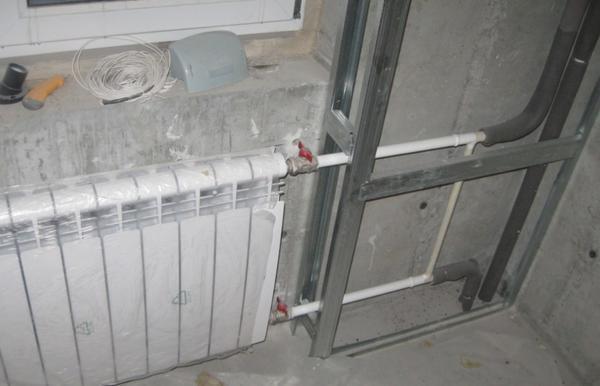
First you need to make the frame of the box. The material of manufacture is fixed with self-tapping screws. First, markup the location of communications. Take into account the dimensions of the pipes, the thickness of the material and the interval between the walls of the box and communications.
Do not install pipes close to the box. It is optimal to leave a distance of 3 cm.
Next, install the building profiles. Then fix the guides. To fasten the profiles to each other, cutters are used.
Then mount the corner profiles. If the interval between the racks exceeds 25 cm, then additional jumpers should be made. If the height of the racks is more than 150 cm, then horizontal jumpers are mounted. When the frame is ready, begin its design. Bevels are removed from drywall before installation. But if tiling is planned in the future, then this process can be omitted.
They start installing the walls of the box from the side parts and move towards the central ones. After installing the walls, the box must be trimmed decoratively. To do this, use tiles, wallpaper paint.
If you want to hide the batteries, you can build a false wall. The execution technology is similar to the box. First, the frame is made, then the walls are sheathed. A significant drawback of this method of decorating is a decrease in the area of \u200b\u200bthe room. If you don’t want to bother with installing these elements, then you can purchase a ready-made box in a hardware store.
Interesting design solutions for decorating pipes
If you decide to decorate pipes on your own, you will first need to familiarize yourself with a wide range of design solutions. Staining is the most popular method. You can not only paint the plumbing element in the desired color, but also draw absolutely any pattern on it. Tree branches will look very impressive. Such decor is within the power of any person. Art education is optional.
Depending on the style of the room, the decor of the gas or heating pipe, painted in bronze, gold or silver, looks spectacular.
When choosing a color, pay attention to the color of the wallpaper, doors, window sills
If you are looking for the least expensive way, then try using jewelry for decoration purposes. You can decorate pipes with a wide variety of decorative elements. Materials such as ribbons, buttons, fringes, laces, fabric, fur, beads and much more are perfect for this purpose.
Try decorating your pipe with a variety of animal, insect, or homemade toys. At the same time, the pipe itself can be painted to match the color of the tree trunk.
The heating pipe can be decorated with stained glass windows. At first glance, this method may seem incredible.Glass or transparent plastic is used for decoration. This method of decoration can be safely combined with a variety of lighting techniques. In addition, such a spectacular composition can serve as a night light indoors.
Types of decorative screens
All means for performing hidden laying of heating pipes can be divided into 2 groups:
- products of factory readiness;
- homemade boxes.
The first group is screens sold ready-made. Their advantage is low cost and ease of installation. You do not need to invent anything for the heating pipes, it is enough to assemble the finished structure and attach it according to the instructions. An additional advantage of such screens is that in the event of an accident or the need to replace the pipe, the box is just as easy to remove as it is to be mounted.
For reference. There are whole sets of decorative screens on the market, including a box for a battery and a pipe, made of the same material.
There are no serious flaws in the factory screens. What makes many homeowners sew up an objectionable pipe with drywall or plastic? The answer is simple: a drywall box covers the riser completely, while it becomes possible to veneer it as you like and fit it into any interior. Despite the wide choice, factory products are not so diverse as to satisfy all homeowners, and some simply do not like them, this is a matter of taste.
In turn, deaf home-made drywall screens have one drawback of the technical plan. The fact is that the riser, located in a closed space, heats the air inside it 5-10 degrees higher than in the room. At the same time, almost no heat enters the room from it. If we are talking about an apartment, then blank screens for heating pipes deprive you of a legitimate share of heat, for which you pay a lot of money.
The second nuance: the temperature difference between the closed space of the box and the street increases, therefore, heat transfer is more intense towards the street, and not towards the room. In simple terms, this means that you pay for heating the environment. But there is a way out: it is high-quality thermal insulation of the pipe under the drywall, which will lead to additional costs.
